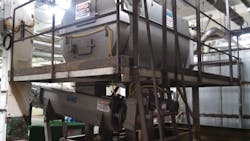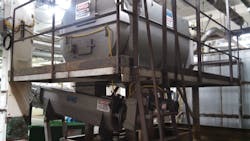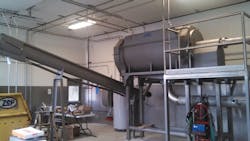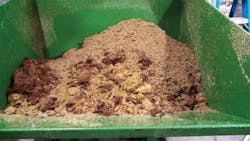By Bob McGowan and Stacy Peshkopia
Drop into any local bar and you’re bound to see a few craft beers on tap beside the well-known domestic drafts. Nearly two craft breweries open every day in the United States, adding to the more than 4,000 craft breweries already serving up beer across the nation. The last surge in locally-owned and operated breweries was in the 1880s. Now, IPAs, locally-crafted hefeweizens and even sour beers are on tap at bars everywhere. From the creatively crafted tap handles to the shiny fermentation tanks, it’s clear: craft beer is here to stay.
The revived “farm-to-table” mentality opened the door for independent brewers to find more secure footing in a market that just decades ago was nearly nonexistent. This growth in demand for craft beer is accompanied by an increase in challenges for the less glamorous side of beer production - the wastewater created by the brewing process.
Brewing beer is water-intensive. For just one gallon of beer produced, six to eight gallons of water are required. While some of that water does end up in bottles, cans, kegs, or as steam during the sanitation process, more than half of it ends up as wastewater.
Unlike what’s typically found in municipal waste streams, the waste enzymes that result from beer brewing cause considerable disruption to the entire sewer system. Waste from beer comprises sugar, yeast and complex proteins that - in significant enough quantities - can dramatically change the microbial makeup of the waste stream. To reduce the biological oxygen demand (BOD) from these compounds, some forward-thinking breweries have chosen an anaerobic digester to combat waste disposal issues. However, pretreatment of the brewery wastewater to remove coarse solids, like hops and spent grains, before they reach the anaerobic digester is critical for optimal system functionality, and will assist the digester with further successful breakdown of organic materials.
Medium to large breweries can rely on internally-fed rotary screening systems, which are an economical, reliable pretreatment solution. They help eliminate suspended solids, like spent hops and grains, from the waste stream. Anaerobic digesters are then able to function at full productivity, while more solid waste is compacted, dried and altogether eliminated from the wastewater thanks to the screening system. In the end, overall waste output is reduced, so breweries pay fewer fees for landfill transport while maintaining the integrity of their other equipment.
Understanding the cost- and energy-saving benefits of screening systems equips brewery owners to more successfully manage their wastewater and focus on their craft.
Screening the Mix
To truly understand how significant rotary screening systems are to a large-scale brewery operation, you need to break down the brewing process.
Beer is made from barley malt that is ground and mixed with other grains to fuel the fermentation process. These ingredients are mixed with water and mashed so that the grain starches are converted to smaller carbohydrates, mostly fermentable sugars. This mash is separated into a clear liquid called wort, which contains the sugars and other grain-derived components, as well as the non-soluble spent grains.
The wort and hops are boiled in the brew kettle to extract the hop resins and oils. The boiled-out spent hops are usually added to the spent grain. For breweries that produce more than 50,000 barrels a year, that ends up being an enormous volume of spent hops in need of disposal. If left within the system, that grain can cause significant damage not only to the brewery process equipment but also to the other facilities, pumps and pipelines further down the wastewater stream.
Some of the nation’s largest craft breweries spend millions of dollars transporting their processed wastewater to cities with more robust treatment systems because their own municipalities simply can’t handle the increased level of BOD. While rotary screening systems don’t make an impact on BOD reduction, eliminating the damage from spent hops and grains to an anaerobic digester mitigates unscheduled maintenance costs and allows brewers to dispose of that waste more effectively.
Method of Operation
Internally-fed rotary screens are designed for the high flow rate/low solids content of brewery wastewater but are also ideal for managing other municipal and industrial wastewater. The cylindrical drums are mounted horizontally on four shaft-mounted trunnions that are supported on pillow block bearings. The influent - in this case, brewery wastewater - enters an engineered headbox where the flow energy is dissipated and is evenly distributed onto the interior sidewalls of the drum. The spent hops and grains are retained on the screen surface, and the wastewater flows radially through the screen openings. Splash guards direct the liquid filtrate to a central drainage area, and the spent hops and grains are transported axially, by flights, to the open end of the drum. The rotation of the drum allows the entire screening surface to be continuously or intermittently washed by a fixed, external spray bar.
Case Study: Matt Brewing Company (Utica, NY)
Matt Brewing Company is a picture of sustainability in the craft brewing community, using several energy-saving methods within its brewing process. An on-site 200,000-gallon equalization tank normalizes the flow of the wastewater and preconditions it before entering the company’s digester units. The wastewater is pumped from the equalization tank to five anaerobic digester tanks located 50 to 150 feet away. The 40,000-gallon digester tanks can be operated in parallel or in a series. Organics in the digester tanks are treated by a mixture of anaerobic bacteria that create biogas composed of methane gas and carbon dioxide.
Nearly 900 gallons of wastewater flow through the system every minute, including tough, gritty spent hops. To protect the heat exchanger before the digester, the company was using a two-dimensional filter to capture this material. However, the spent hops regularly clogged the filter, and operators had to clean it manually each time. After dealing with this issue for years, the executive team conducted research on alternative screening products. This led them to choose an internally fed rotary screen, which catches the spent grain but allows the yeast to flow through to the digester. The rotary screen removes the solids from the wastewater stream, and compresses them for dryer, more compact discharge.
Since the installation, Matt Brewing Company has eliminated costly downtime due to filter maintenance and hasn’t experienced any issues with its anaerobic digester related to spent hops or grains.
The Future of Industrial Pretreatment
For all the joys of craft beer, there are wastewater challenges that accompany the brewing process. As existing craft breweries expand their operations, and new breweries open their doors, thoughtful pretreatment options will be crucial to limiting the impact of waste on both sensitive process equipment and the entire wastewater system of the municipality. Evaluating pretreatment screens based on the debris makeup, flow rate and end use for the screenings will enable facilities to gain the greatest cost savings and productivity benefits of the screening solution. Bottoms - and screens - up!
About the Authors: Bob McGowan is the industrial sales manager and Stacy Peshkopia is global product manager for commercial and industrial products, both with JWC Environmental. Learn more at www.jwce.com.





